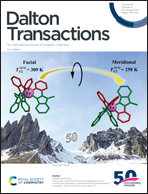Tuning spin-crossover transition temperatures in non-symmetrical homoleptic meridional/facial [Fe(didentate)3]2+ complexes: what for and who cares about it?†
Abstract
The [FeN6] chromophores found in [Fe(didentate)3]2+ complexes, where didentate is a non-symmetrical 2-(6-membered-heterocyclic ring)-benzimidazole ligand (Lk), exist as mixtures of two geometrical mer (C1-symmetry) and fac (C3-symmetry) isomers. Specific alkyl-substituted six-membered heterocyclic rings connected to the benzimidazole unit (pyridines in ligands L1–L3, pyrazines in L4–L5 and pyrimidines in L6–L7) control the ligand field strength and the electron delocalization so that [FeII(Lk)3]2+ display tunable thermally-induced spin transitions in solution. Thermodynamic, spectroscopic (UV-Vis, NMR) and magnetic studies in solution demonstrate that [Fe(L6)3]2+ (L6 = 1-methyl-2-(pyrimidin-2-yl)-1H-benzo[d]imidazole) exhibits a close to room temperature spin transition (T1/2 = 273(3) K) combined with a high stability formation constant ( in acetonitrile), which makes this complex suitable for the potential modulation of lanthanide-based luminescence in polymetallic helicates. A novel method is proposed for assigning specific thermodynamic spin crossover parameters to fac-[Fe(L6)3]2+ and mer-[Fe(L6)3]2+ isomers in solution. The observed difference relies mainly on the entropic content ΔSmerSCO − ΔSfacSCO = 11(1) J mol−1 K−1, which favors the spin transition for the meridional isomer. Intermolecular interactions occurring in the crystalline state largely overcome minor thermodynamic trends operating in diluted solutions and a single configurational isomer is usually observed in the solid state. Among the thirteen solved crystal structures 1–13 containing the [M(Lk)3]2+ cations (M = Fe, Ni, Zn, Lk = L6–L7), pure meridional isomers are observed six times, pure facial isomers also six times and a mixture (44% mer and 56% fac) is detected only once. Solid-state magnetic data recorded for the FeII complexes show the operation of slightly cooperative spin transitions in 7 (fac-[Fe(L6)3]2+) and 12 (mer-[Fe(L7)3]2+). For the meridional isomer in 6, a two-step spin state transition curve, associated with two phase transitions, is detected.
in acetonitrile), which makes this complex suitable for the potential modulation of lanthanide-based luminescence in polymetallic helicates. A novel method is proposed for assigning specific thermodynamic spin crossover parameters to fac-[Fe(L6)3]2+ and mer-[Fe(L6)3]2+ isomers in solution. The observed difference relies mainly on the entropic content ΔSmerSCO − ΔSfacSCO = 11(1) J mol−1 K−1, which favors the spin transition for the meridional isomer. Intermolecular interactions occurring in the crystalline state largely overcome minor thermodynamic trends operating in diluted solutions and a single configurational isomer is usually observed in the solid state. Among the thirteen solved crystal structures 1–13 containing the [M(Lk)3]2+ cations (M = Fe, Ni, Zn, Lk = L6–L7), pure meridional isomers are observed six times, pure facial isomers also six times and a mixture (44% mer and 56% fac) is detected only once. Solid-state magnetic data recorded for the FeII complexes show the operation of slightly cooperative spin transitions in 7 (fac-[Fe(L6)3]2+) and 12 (mer-[Fe(L7)3]2+). For the meridional isomer in 6, a two-step spin state transition curve, associated with two phase transitions, is detected.
![Graphical abstract: Tuning spin-crossover transition temperatures in non-symmetrical homoleptic meridional/facial [Fe(didentate)3]2+ complexes: what for and who cares about it?](/en/Image/Get?imageInfo.ImageType=GA&imageInfo.ImageIdentifier.ManuscriptID=D0DT03828H&imageInfo.ImageIdentifier.Year=2021)


 Please wait while we load your content...
Please wait while we load your content...